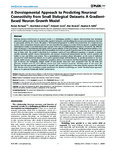A developmental approach to predicting neuronal connectivity from small biological datasets: a gradient-based neuron growth model.
| dc.contributor.author | Borisyuk, R | en |
| dc.contributor.author | Al Azad, AK | en |
| dc.contributor.author | Conte, D | en |
| dc.contributor.author | Roberts, A | en |
| dc.contributor.author | Soffe, SR | en |
| dc.date.accessioned | 2016-06-02T11:59:47Z | |
| dc.date.available | 2016-06-02T11:59:47Z | |
| dc.date.issued | 2014 | en |
| dc.identifier.uri | http://hdl.handle.net/10026.1/4794 | |
| dc.description | PMCID: PMC3931784 Open Access article: BB/G006652/1 and BB/G006369/1. | en |
| dc.description.abstract |
Relating structure and function of neuronal circuits is a challenging problem. It requires demonstrating how dynamical patterns of spiking activity lead to functions like cognitive behaviour and identifying the neurons and connections that lead to appropriate activity of a circuit. We apply a "developmental approach" to define the connectome of a simple nervous system, where connections between neurons are not prescribed but appear as a result of neuron growth. A gradient based mathematical model of two-dimensional axon growth from rows of undifferentiated neurons is derived for the different types of neurons in the brainstem and spinal cord of young tadpoles of the frog Xenopus. Model parameters define a two-dimensional CNS growth environment with three gradient cues and the specific responsiveness of the axons of each neuron type to these cues. The model is described by a nonlinear system of three difference equations; it includes a random variable, and takes specific neuron characteristics into account. Anatomical measurements are first used to position cell bodies in rows and define axon origins. Then a generalization procedure allows information on the axons of individual neurons from small anatomical datasets to be used to generate larger artificial datasets. To specify parameters in the axon growth model we use a stochastic optimization procedure, derive a cost function and find the optimal parameters for each type of neuron. Our biologically realistic model of axon growth starts from axon outgrowth from the cell body and generates multiple axons for each different neuron type with statistical properties matching those of real axons. We illustrate how the axon growth model works for neurons with axons which grow to the same and the opposite side of the CNS. We then show how, by adding a simple specification for dendrite morphology, our model "developmental approach" allows us to generate biologically-realistic connectomes. | en |
| dc.format.extent | e89461 - ? | en |
| dc.language | eng | en |
| dc.language.iso | eng | en |
| dc.title | A developmental approach to predicting neuronal connectivity from small biological datasets: a gradient-based neuron growth model. | en |
| dc.type | Journal Article | |
| plymouth.author-url | http://www.ncbi.nlm.nih.gov/pubmed/24586794 | en |
| plymouth.issue | 2 | en |
| plymouth.volume | 9 | en |
| plymouth.journal | PLoS One | en |
| dc.identifier.doi | 10.1371/journal.pone.0089461 | en |
| plymouth.organisational-group | /Plymouth | |
| plymouth.organisational-group | /Plymouth/Faculty of Science and Engineering | |
| plymouth.organisational-group | /Plymouth/Users by role | |
| plymouth.organisational-group | /Plymouth/Users by role/Researchers in ResearchFish submission | |
| dc.publisher.place | United States | en |
| dc.identifier.eissn | 1932-6203 | en |
| dc.rights.embargoperiod | Not known | en |
| rioxxterms.versionofrecord | 10.1371/journal.pone.0089461 | en |
| rioxxterms.licenseref.uri | http://www.rioxx.net/licenses/all-rights-reserved | en |
| rioxxterms.type | Journal Article/Review | en |
| plymouth.funder | Cross-modality integration of sensory signals leading to initiation of locomotion::BBSRC | en |
| plymouth.funder | Cross-modality integration of sensory signals leading to initiation of locomotion::BBSRC | en |
| plymouth.funder | Cross-modality integration of sensory signals leading to initiation of locomotion::BBSRC | en |
| plymouth.funder | Cross-modality integration of sensory signals leading to initiation of locomotion::BBSRC | en |


